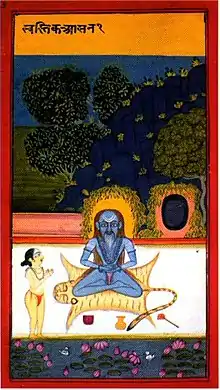Svastikasana
Svastikasana (Sanskrit: स्वस्तिकासन, IAST svastikāsana) is an ancient meditation asana in hatha yoga, sitting cross-legged.

In Sanskrit svastika means auspicious; it is also the name of an ancient Hindu symbol of good fortune.
Etymology and origins
The name comes from the Sanskrit words svastika (स्वस्तिक) meaning "auspicious" and āsana (आसन) meaning "posture" or "seat". The posture is described in the eighth century Pātañjalayogaśāstravivaraṇa and in the tenth century Vimānārcanākalpa, where it is a meditation seat.[1]
Description
Sitting cross-legged on the floor, place the left toe on the right knee fold. Put your right foot on the left knee fold. This asana is always done in the same way for men and women, different from those that have polarity like Padmasana, Siddhasana and others.
Svastikasana is calm sitting with upright (upper) body. Stretch the legs forward. Bend the left leg in the way that you place the foot near the right thigh muscle. Bend, as it were, the right leg and "press" it into the space between the left thigh and calf muscles. So you will now find the two feet placed between thighs and calves of the legs.[2]
Usage
Swastikasana, Sukhasana, Siddhasana and Padmasana are the asanas traditionally used for dhyana (meditation) and pranayama (breath) exercises.[3]
See also
References
- Mallinson, James; Singleton, Mark (2017). Roots of Yoga. Penguin Books. pp. 97–98, 100–101. ISBN 978-0-241-25304-5. OCLC 928480104.
- Sivananda, Swami. "Yoga Asanas".
- Upadhyaya, Rajnikant; Sharma, Gopal (1 January 2006). Awake Kundalini. Lotus Press. p. 54. ISBN 978-81-8382-039-4.
Further reading
- Iyengar, B. K. S. (1 October 2005). Illustrated Light On Yoga. HarperCollins. ISBN 978-81-7223-606-9.
- Saraswati, Swami Janakananda (1 February 1992). Yoga, Tantra and Meditation in Daily Life. Weiser Books. ISBN 978-0-87728-768-1.
- Saraswati, Swami Satyananda (1 August 2003). Asana Pranayama Mudra Bandha. Nesma Books India. ISBN 978-81-86336-14-4.
- Saraswati, Swami Satyananda (January 2004). A Systematic Course in the Ancient Tantric Techniques of Yoga and Kriya. Nesma Books India. ISBN 978-81-85787-08-4.
_from_Jogapradipika_1830_(detail).jpg.webp)

